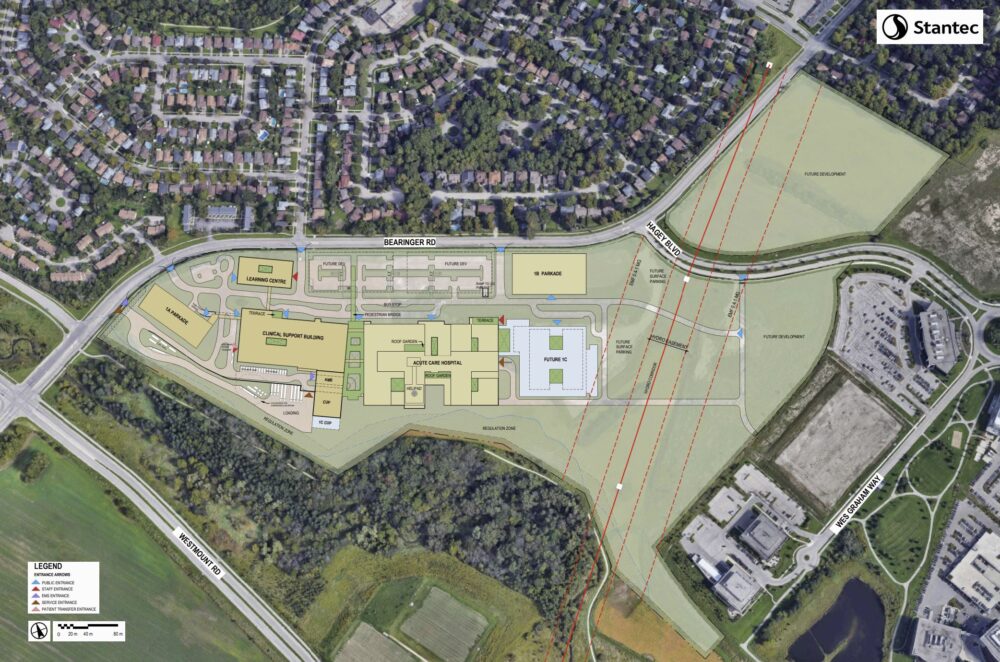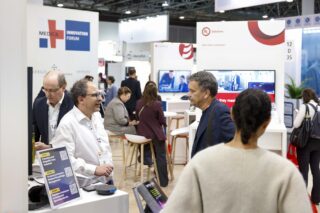Panelists focused on community engagement and involvement in the design of a new hospital in Canada’s Waterloo region during the European Healthcare Design event held at the Royal College of Physicians in London this week.
Clifford Harvey, joint vice president, redevelopment, Grand River Hospital/St Mary’s General Hospital in Canada; Diego Morettin, partner, DIALOG; and Dorsa Jalalian, associate and senior urban designer, DIALOG, gave the talk entitled St. Mary’s and Grand River Hospitals: A unified vision for community wellbeing, collaboration and innovation, which was moderated by chair John Cooper of JCA.
Harvey kicked off the well-attended speech with an overview of the project, which involved merging St Mary’s and Grand River hospitals in the Kitchener-Waterloo region in Ontario, Canada to create a new facility.
The project started, he said, with coming up with a concept for how the hospital would look and then engaging DIALOG, who, with the help of the Conference Board of Canada, created a design management tool called the Community Wellbeing Framework to measure the project’s progress and to see if it’s meeting its goals.
“It’s a tool to imagine what healthcare can be delivered through the project and, in doing so, look at the social and economic part of technology, sustainability, population health, and engagement,” said Harvey.
The Five Key Design Domains
Harvey then handed over to Morettin, who said that DIALOG had studied more than 3,000 pieces of literature and spoke with experts including chief medical officers, municipalities, and clients to inform its definition of community wellbeing. Based on that, he outlined the five key domains that will be used to measure the project’s success.
The first domain, Morettin said, was the social element. A key part of this, he said, was the building should be welcoming and safe, and have areas where people can socialize, given the health benefits that it can provide.
The second one, Morettin said, was environmental. That involves, he said, creating spaces that people want to enjoy and they can connect with nature, as well as giving them access to clean air and water.
The next theme, Morettin said, was economic. That means, he said, ensuring all of the facilities it provides are affordable and enable people to complete their daily activities.
The final two domains, Morettin said, were cultural and political. The former, he said, was about creating a place that has a feeling of community, while the latter requires collaboration and ensures that a diverse set of views is reflected in the design.
“The key to all this is that it can be used as a tool to improve community wellbeing through design,” said Morettin.
Engaging the Local Community
His colleague Jalalian then spoke about the engagement process with all of the project’s key stakeholders. That started, she said, by consulting with 140 hospital leaders in a workshop, where they were asked to envision the hospital’s future while ensuring the five key domains were covered in various aspects. After studying magazines and other printed materials on the future of the hospital, she said they selected the images and phrases that most resonated with them.
Participants then carried out a role play to imagine what the new hospital would look like from the perspective of the other people who will be using it, said Jalalian. She said that the conversation continued with the Building the Future of Care Together community, which included eight board members, the CEO, President, and Chief of Staff.
The next step, Jalalian said, was to launch an online survey, which drew more than 330 detailed responses on what the future hospital should look like from the broader community. Then, a series of pop-up events were held at farmers’ markets, community centers, and hospital campuses and lobbies to canvas the views of more than 400 people
“Overall, we had over 1,000 voices who contributed to the engagement process,” said Jalalian. “The final outcome was a design document that lays out both a clear vision and a series of design metrics that have real purpose and that we can use at the design stage. “Right now, we are undertaking a study of the social and economic impact that the hospital will have on the community. Not only are we looking at the design metrics and KPIs, but we are also identifying the benefits that it’s going to have on the community.”
Harvey wrapped up by saying:
“The key takeaways are that we are designing for people’s wellbeing, not just for healthcare, and that the community voice is the driver of the design. Also, full engagement with the indigenous population is key, where we are on treaty land in the Six Nations and we’re working closely with them to understand what their needs are, and to establish a shared vision for the region.”










